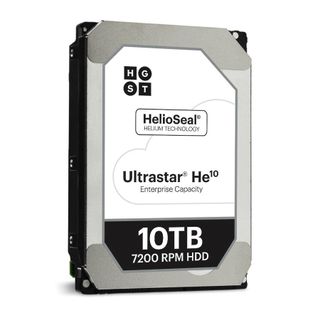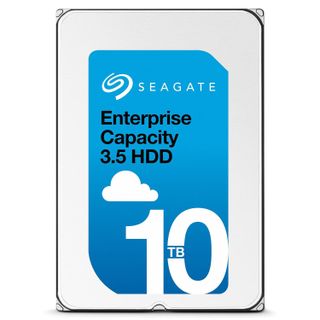Big HDD Showdown: Seagate 10TB vs. HGST Ultrastar He10 vs. WD Gold 8TB
OLTP And Email Server Workloads
To read more on our test methodology visit How We Test Enterprise HDDs, which explains how to interpret our charts. We cover workload performance measurements on page four, latency measurements on page five and power measurements on page six.










Intense server workloads with transactional data are, admittedly, going to be a rare use case for these drives (unless users deploy them into existing architectures). HDDs continue to dominate in terms of overall storage capacity, but SSDs have overtaken the drives for most transactional workloads with new systems. However, examining mixed workload performance provides additional insight into the agility of the drive.
The HGST drives continue to display reduced performance during heavy workloads. The Seagate and HGST 10TB drives offer similar performance during the lighter portions of the workloads, which is the most important section of the test. We also note a bit of separation between the WD Gold and the He8, with the He8 offering a better performance profile.
Once again, we note that the HGST He10 suffers a performance reduction under heavy workloads in the latency over IOPS and QoS charts. However, it leads under light conditions with a higher peak output, which indicates that HGST has specifically tuned the drive for the more common workloads.
The power testing during the workload doesn't reveal any surprises; it is the same trend that we observed during the other tests.










The HGST He10 and Seagate 10TB continue to be closely matched during the lighter portions of the workload, but the Seagate pulls ahead as intensity increases beyond QD64. The two drives offer nearly the same performance under the lightest workloads, as seen in the latency subcharts, but the HGST offers the advantage of a higher peak performance at QD64. The He10 also offers a superior profile during the 32QD QoS breakout.
Surprisingly, the 12Gb/s SAS He10 pulls within a watt of the SATA 6Gb/s Seagate 10TB, which indicates that the SATA He10 likely offers superior power efficiency metrics.
Current page: OLTP And Email Server Workloads
Prev Page 128KB Sequential Read And Write Next Page AnalysisStay on the Cutting Edge
Join the experts who read Tom's Hardware for the inside track on enthusiast PC tech news — and have for over 25 years. We'll send breaking news and in-depth reviews of CPUs, GPUs, AI, maker hardware and more straight to your inbox.

Paul Alcorn is the Managing Editor: News and Emerging Tech for Tom's Hardware US. He also writes news and reviews on CPUs, storage, and enterprise hardware.
-
Bret_Schumacher You should have compared it to the 10TB gold which had "supposedly" higher read/write rates comparable to seagate and hgstReply -
PaulAlcorn Reply18389500 said:You should have compared it to the 10TB gold which had "supposedly" higher read/write rates comparable to seagate and hgst
I agree. The 10TB Gold was only announced two days ago. We inquired with WD, but samples are not ready yet.
-
AndrewJacksonZA I know that your review uses the pricing that you have at hand, but as I'm reading the article, your ads are displaying prices as follows:Reply
HGST ULTRASTAR HE10 - $506 on Amazon
SEAGATE ENTERPRISE CAPACITY 10TB - $589 on Amazon
WD GOLD 8TB - $600 on Newegg
The HE10 in the review is taken as the most expensive drive when it's actually the cheapest. Would you consider revising your pros and cons for each drive's cost?
Thank you -
PaulAlcorn Reply18389599 said:I know that your review uses the pricing that you have at hand, but as I'm reading the article, your ads are displaying prices as follows:
HGST ULTRASTAR HE10 - $506 on Amazon
SEAGATE ENTERPRISE CAPACITY 10TB - $589 on Amazon
WD GOLD 8TB - $600 on Newegg
The HE10 in the review is taken as the most expensive drive when it's actually the cheapest. Would you consider revising your pros and cons for each drive's cost?
Thank you
Prices fluctuate, and it varies between retailers. Usually we do not provide a graph with low, average, and high values, but I added it due to the big price variation between retailers. It isn't a perfect system, but retail pricing is our only resource.
The $500 for the HGST He10 is noted in the 'low' category, but the drive is still retailing at CDW for $855.
-
3ogdy Reply18389819 said:No Seagate for me. Their drives are notoriously unreliable and always fail on us.
THERE.YOU.GO. Once again another one just like me...
Seagate hard drives have proven to be extremely unreliable for me too. This company is an absolute nightmare. I have quite a few 7200.12 500GB and 7200.14 2TB Barracudas that simply stopped working. Some of them, in a very convenient way, right after the 2yr warranty - even though that doesn't cover data recovery, of course.
Once my last 7200.14 2TB Barracuda went belly up...I had to cough up over $1000 to ship that POS to the Netherlands and have my data sent back to me on an external Seagate drive. VERY poor quality products from this company. I'm terrified at the thought of using anything from Seagate to store my data on. I lost countless projects, personal data and things I needed, but Seagate isn't gonna get a copulating cent from me anymore. I'm not touching anything coming from them and they can easily rest assured none of my clients EVER will.
Another detail I'd mention is this: I was on the phone with a Seagate representative and I told them how everything happened (well, basically my partitions were not there in Windows, the drive didn't show up under Device Management...). I'm asked for a serial number and then I'm told: You've just lost your warranty on your Seagate product. (it was legally under warranty that I could have claimed through the shop I got the drive from)
EXCUSE ME?
Very bad customer experience - building HDDs to get people to call on you for data recovery and pay over 15x the price of your POS product in order to get their data back. Your business model is not focused on providing reliable storage systems ( HDDs ) - you're not an HDD manufacturer at heart - you're a data recovery company.
WELL DONE WE'RE DONE, Seagate.
Also, shall I mention there's a class action suit being prepared against Sh*tgate at the EU level?
HGST (WD subsidiary) has proven much more reliable throughout the years and they also provide a 5 years warranty (data recovery not included, of course).
P.S. NEVER provide your HDD's serial number to Seagate on the phone.
The lesson I'm teaching everyone I can around me is NEVER EVER trust your data to Seagate. NEVER use Seagate products as they don't stand by them and are only interested in making your pockets lighter. Even friends who weren't aware about this company now know what to avoid in their systems.
Whenever you have to choose storage - consider SSDs first and if capacities don't fit the budget, pick something more reliable from either HGST, WD...I can't really speak for Toshiba drives but I doubt they're as problematic as Seagate's I rememebr reading Backblaze's reliability reports and thinking : It all makes sense to me now. People said they hadn't tested Seagate drives properly and that their technique was flawed, but they were right. -
RedJaron Paul, any chance you or Chris R might review a basic consumer spindle drive soon? I know they're not the "sexy" thing right now with new SSDs and high-capacity enterprise storage getting released. But considering most consumer builds still include a TB or two of spindle storage, I'd be interested to see if there have been any significant advances in the last 3 - 5 years. In particular, the WD Blue 1TB is 7200 rpm while the 2TB model is 5400 rpm. Is 5400 still a curse word in today's spindle drives?Reply -
PaulAlcorn Reply18390300 said:Paul, any chance you or Chris R might review a basic consumer spindle drive soon? I know they're not the "sexy" thing right now with new SSDs and high-capacity enterprise storage getting released. But considering most consumer builds still include a TB or two of spindle storage, I'd be interested to see if there have been any significant advances in the last 3 - 5 years. In particular, the WD Blue 1TB is 7200 rpm while the 2TB model is 5400 rpm. Is 5400 still a curse word in today's spindle drives?
There is actually something in the pipeline right now, so we should have something for you soon(ish). I am not sure about the test pool yet, but those are good suggestions. :)
-
logainofhades I really want 2x8tb drives for a Raid 1 setup, but the cost is still too high. :(Reply


